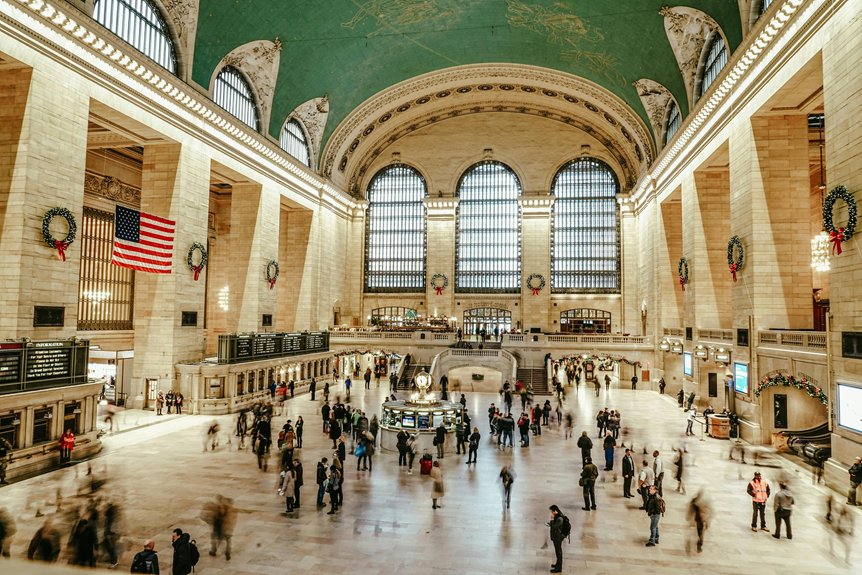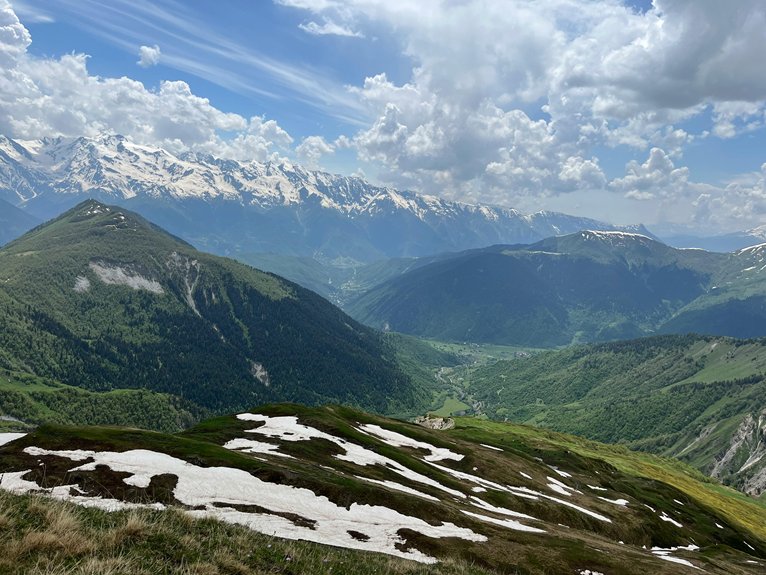25 Fun Facts You Didn’t Know About New York City

Have you ever wondered what makes New York City so unique? From its iconic landmarks to its rich history, there’s more to NYC than meets the eye. Did you know the Statue of Liberty was a gift from France or that the subway system is one of the largest in the world? These intriguing facts are just the beginning. Let’s explore more surprising details that define this vibrant metropolis.
The Statue of Liberty Was a Gift From France
When you think of iconic landmarks, the Statue of Liberty certainly comes to mind, standing proudly as a symbol of freedom and hope.
This stunning statue was a French gift, given in 1886 to celebrate the enduring friendship between France and the United States.
Its symbolic meaning resonates worldwide, representing liberty, democracy, and the welcoming spirit of New York City for immigrants seeking a better life.
NYC Has Its Own Time Zone
While the Statue of Liberty stands as a beacon of hope and connection between nations, New York City also boasts a unique aspect that sets it apart from the rest of the country: its own time zone.
Known as New York Time, this time zone helps you sync your bustling city life with events, meetings, and the vibrant culture that thrives around you.
There Are Over 800 Languages Spoken
Imagine walking through New York City, where every block offers a new language echoing in the air.
This incredible linguistic diversity reflects the vibrant cultural neighborhoods shaped by historical migration patterns.
You’ll find that each language tells a story, creating a rich tapestry of experiences that truly defines the city’s spirit.
Linguistic Diversity Celebration
New York City is a vibrant tapestry of cultures, where the air buzzes with the sounds of over 800 languages, making it one of the most linguistically diverse places on the planet.
Celebrate this diversity through:
- Community language classes
- Language preservation initiatives
- Multilingual education programs
- Cultural festivals
These efforts foster understanding, promote inclusivity, and guarantee that every voice is heard in the city’s rich mosaic.
Cultural Neighborhoods Influence
As you stroll through the bustling streets of New York City, you’ll quickly notice how each neighborhood reflects its unique cultural heritage, shaped by the myriad of languages spoken by its residents.
This cultural fusion creates vibrant atmospheres, especially during neighborhood festivals, where you’ll experience colorful parades, delicious foods, and traditional music, showcasing the rich tapestry of life in this incredible city.
Historical Migration Patterns
While exploring the diverse neighborhoods of New York City, you can’t help but notice the incredible linguistic diversity that reflects its historical migration patterns.
Key factors include:
- Early immigration waves from Europe.
- The impact of the Great Migration.
- Recent influxes from Asia and Latin America.
- Cultural assimilation shaping new communities.
These elements create a vibrant tapestry of over 800 languages spoken throughout the city.
The Subway System Is One of the Largest in the World
When you hop onto the New York City subway, you’re stepping into one of the largest and most intricate transit systems in the world.
With its extensive network covering all five boroughs, the subway not only connects millions of commuters but also showcases the city’s rich history and unique art installations.
Extensive Network Coverage
New York City’s subway system boasts an impressive 472 stations and spans over 665 miles of track, making it one of the largest and most extensive networks in the world.
With this vast coverage, you can enjoy:
- Convenient access to neighborhoods
- Enhanced broadband accessibility
- Improved mobile connectivity
- Efficient commuting options
Explore the city seamlessly as you ride this iconic transit system!
Historical Significance
As you explore the rich tapestry of New York City’s history, you’ll discover that its subway system stands as a monumental achievement in urban engineering.
Emerging amidst colonial architecture and revolutionary events, this vast network not only transformed transportation but also shaped the city’s cultural landscape.
With over 450 miles of track, it symbolizes resilience and innovation, connecting diverse communities across the bustling metropolis.
Unique Art Installations
There’s something truly mesmerizing about the unique art installations scattered throughout New York City’s subway system.
From vibrant street murals to stunning interactive sculptures, these installations transform your commute into an art walk.
Check out:
- Engaging public installations
- Neighborhood murals
- Pop-up galleries
- Urban art featured in art festivals
Explore these community projects and outdoor exhibitions that breathe life into the city!
Central Park Is Larger Than the Entire City of Boston
Did you know that Central Park spans a staggering 843 acres, making it larger than the entire city of Boston? This urban greenery offers more space than you might imagine. Check out this Boston comparison:
| Location | Size (Acres) |
|---|---|
| Central Park | 843 |
| Boston | 90.5 |
| Difference | 752.5 |
Explore this vast oasis in the heart of NYC!
The Empire State Building Has Its Own ZIP Code
Nestled among the towering skyscrapers of Manhattan, the iconic Empire State Building stands out not just for its breathtaking views but also for its unique distinction of having its own ZIP code: 10118.
Here’s why that’s special:
- It’s a landmark.
- It serves thousands daily.
- It enhances mail delivery efficiency.
- It symbolizes New York’s grandeur.
This ZIP code adds to the Empire State’s allure!
NYC Was Once the Capital of the United States
Did you know that New York City once held the prestigious title of the capital of the United States?
For a brief period from 1785 to 1790, this bustling metropolis was the heart of the nation’s government before it shifted to Philadelphia.
Understanding this historical significance adds another layer to your appreciation of NYC’s rich past.
Historical Significance of NYC
New York City, a vibrant tapestry of history and culture, once held the prestigious title of the capital of the United States.
Its historical significance is evident in:
- The Federal Hall, where George Washington took his oath.
- The city’s colonial heritage reflected in architecture.
- The remarkable Battery Park.
- The iconic Fraunces Tavern.
These historical landmarks tell stories of the nation’s early days.
Duration as Capital
After exploring the historical significance of landmarks like Federal Hall and Fraunces Tavern, it’s fascinating to contemplate the time when NYC served as the capital of the United States.
From 1785 to 1790, New York was the heart of the nation’s government, shaping early American history.
This period marked a vital shift, underscoring the city’s lasting significance in American politics and identity.
Transition to Philadelphia
Although many might associate Philadelphia with its pivotal role in American history, the change from New York City as the nation’s capital was a significant turning point.
Discover how this alteration shaped the city:
- Home of the Liberty Bell
- Rich Philadelphia history
- Birthplace of cheesesteak origins
- Vibrant cultural festivals
These elements make Philly a dynamic hub of urban parks, museums, and historical landmarks.
The City Has More Than 200 Museums
With over 200 museums scattered throughout its vibrant streets, New York City offers an endless array of artistic and cultural experiences waiting to be explored.
From renowned institutions showcasing masterpieces to smaller venues featuring niche collections, the museum variety is astounding.
You can immerse yourself in fascinating cultural exhibitions, making each visit a unique adventure that broadens your understanding of art and history.
There’s a Secret Underground City
Beneath the bustling streets of New York City lies a hidden network of subway tunnels and abandoned stations waiting to be explored.
You can uncover this secret underground city through special tours that reveal its fascinating history and stories.
Imagine wandering through forgotten platforms and dimly lit corridors, where time seems to stand still amidst the city’s vibrant energy above.
Hidden Subway Tunnels
As you wander through the bustling streets of New York City, you mightn’t realize that a hidden world lies beneath your feet, teeming with history and intrigue.
Discover the secrets of the hidden tunnels and forgotten stations:
- Abandoned trackways
- Underground art installations
- Historic utility tunnels
- Unused subway lines
These hidden gems reveal a fascinating layer of the city’s vibrant past.
Abandoned Stations Tour
Imagine stepping into a world where time stands still, hidden beneath the bustling streets of Manhattan.
On the Abandoned Stations Tour, you’ll explore stunning abandoned architecture, remnants of a forgotten era. Each station reveals hidden history, whispering stories of the past.
As you wander through these atmospheric spaces, you’ll uncover the secrets of New York City’s underground city, a fascinating experience you won’t forget.
The Brooklyn Bridge Was the First Steel-Wire Suspension Bridge
The Brooklyn Bridge stands as a monumental achievement in engineering, enchanting visitors with its graceful arches and intricate design.
As the first steel-wire suspension bridge, it revolutionized bridge construction.
Here are some key facts:
- Completed in 1883.
- Spans 1,834 meters.
- Designed by John A. Roebling.
- An iconic symbol of New York City.
This engineering marvel continues to inspire awe today.
New York City Is Home to the World’s Largest Gold Storage
Nestled beneath the bustling streets of Manhattan, you’ll find the world’s largest gold storage, where an astonishing 7,000 tons of gold bullion is securely held.
These gold vaults not only symbolize immense wealth but also provide financial security for the nation.
As you explore this hidden treasure, you can’t help but appreciate the historical significance and the sheer magnitude of what lies beneath your feet.
The New York Public Library Has Over 50 Million Items
With a staggering collection of over 50 million items, the New York Public Library stands as a treasure trove of knowledge and culture.
Its stunning library architecture houses:
- Rare manuscripts
- Historic maps
- Literary treasures from famous authors
- Extensive archives of photographs
Explore this magnificent institution and uncover the stories that shape our world, all within its hallowed halls.
Times Square Was Originally Named Long Acre Square
Long Acre Square once echoed with the sounds of horse-drawn carriages and the hustle of the 19th century.
As you walk through this vibrant area today, remember its origins as a bustling hub for trade and transportation.
The Square’s history transformed when it was renamed Times Square in 1904, marking a new era filled with lights, entertainment, and unforgettable experiences.
The First American Pizzeria Opened in NYC
Did you know that Lombardi’s Pizza, the first American pizzeria, opened its doors in New York City in 1905?
This iconic eatery not only introduced pizza to the American palate but also sparked a culinary revolution that influenced countless pizzerias across the nation.
As you savor a slice, you’re tasting a piece of history that changed the way we think about food in America.
Origin of Lombardi’s Pizza
When you step into Lombardi’s Pizza, you’re not just savoring a slice—you’re experiencing a piece of culinary history. Founded in 1905, this iconic establishment boasts Lombardi’s history and represents the true pizza origins in America.
Here’s what makes it special:
- First pizzeria in the U.S.
- Coal-fired ovens
- Fresh ingredients
- Family recipes
Every bite tells a story!
Cultural Impact on Cuisine
Though it may seem like just a slice of pizza, the establishment of Lombardi’s in New York City profoundly influenced American cuisine.
This iconic pizzeria ignited a wave of food fusion, blending Italian traditions with local flavors. Lombardi’s helped foster culinary diversity, inspiring countless pizzerias across the nation.
Today, you can savor unique toppings and styles, showcasing the rich tapestry of America’s culinary landscape.
The Bronx Is the Only Borough With a Native Plant
The Bronx stands out among New York City’s five boroughs as a unique ecological treasure, home to the only native plant species in the city: the stunning and resilient Eastern black walnut.
This remarkable tree contributes to the borough’s native flora and botanical diversity. Here are some fascinating aspects:
- It produces edible nuts.
- It supports local wildlife.
- It thrives in urban settings.
- It’s a symbol of resilience.
The High Line Was Once an Abandoned Railroad
Shifting from the natural beauty of the Bronx, you’ll find another remarkable aspect of New York City’s landscape: the High Line.
Once an abandoned railroad, this elevated park showcases an inspiring story of urban renewal.
Today, its lush gardens and art installations invite you to stroll along, celebrating the rich High Line history while enjoying stunning views of the city below.
NYC Has Its Own Official Animal
New York City proudly claims the pigeon as its official animal, a feathered symbol of the bustling urban life that surrounds you.
These resilient birds reflect the vibrant city wildlife.
Here are some fun pigeon facts:
- They can find their way home from hundreds of miles away.
- Pigeons can recognize themselves in mirrors.
- They’ve been used in wartime communications.
- Pigeons can live over 15 years.
The City’s Population Is Larger Than Many Countries
Did you know that New York City’s population surpasses that of many countries?
With over 8 million residents, this bustling metropolis is a vibrant tapestry of cultures and backgrounds.
You’ll find an incredible diversity here, making it a unique melting pot unlike anywhere else in the world.
Population Comparison With Nations
Imagine a bustling metropolis where millions of lives intersect daily—this is New York City.
With a population density higher than many nations, it’s fascinating to compare:
- NYC’s population exceeds that of Ireland.
- It’s larger than Panama.
- NYC is more populated than Jamaica.
- It rivals New Zealand.
As one of the world’s leading global cities, New York truly stands out!
Diversity in Demographics
Beyond its impressive population figures, New York City is a vibrant tapestry of cultures, languages, and traditions.
You’ll marvel at the cultural fusion around every corner, with neighborhoods showcasing global cuisines and festivals.
The city thrives on immigrant contributions, shaping its identity and enriching its arts, music, and community life.
This dynamic diversity makes NYC a unique place to explore and experience.
There’s a Hidden Waterfall in the City
While bustling city life surrounds you, a hidden gem awaits just off the beaten path—an enchanting waterfall tucked away in the heart of New York City.
This hidden oasis invites urban exploration with its serene beauty. Don’t miss:
- The soothing sound of cascading water.
- A peaceful escape from the city’s chaos.
- Unique photo opportunities.
- Nearby lush greenery for a perfect backdrop.
NYC Has the Most Skyscrapers in the World
New York City is home to over 8,000 skyscrapers, making it the world’s leader in vertical architecture.
As you wander through the city, you’ll marvel at the stunning skyscraper architecture that defines its urban skyline. Each building tells a story, showcasing innovative design and engineering.
From iconic structures to modern masterpieces, NYC’s skyline captivates everyone who lays eyes on it.
The First Subway in the U.S. Opened in NYC
As you admire the towering skyscrapers that define New York City’s skyline, you mightn’t realize that this bustling metropolis is also home to the first subway system in the United States.
Launched in 1904, it transformed urban transportation.
Here are some highlights of its subway history:
- Over 468 stations
- 24 lines
- 27 million daily riders
- Iconic subway map
The City Is Built on a Series of Islands
Did you know that New York City is actually made up of over 30 islands? This unique island geography shapes the city’s vibrant urban planning. Each island contributes to the diverse culture and infrastructure. Here’s a quick look at some key islands:
| Island | Notable Features |
|---|---|
| Manhattan | Skyscrapers, Central Park |
| Brooklyn | Beaches, Historic Districts |
| Staten Island | Ferry rides, Green spaces |
| Queens | Cultural diversity, Parks |
| The Bronx | Zoo, Botanical Garden |
Coney Island Is Home to the World’s First Roller Coaster
While exploring the thrills of Coney Island, you might be surprised to discover that it’s home to the world’s first roller coaster, the Cyclone.
Here are some fun facts:
- Built in 1927, it’s a classic wooden coaster.
- It reaches speeds of 60 mph.
- It features 12 thrilling turns.
- The ride has over 2,640 feet of track.
Get ready for an unforgettable ride!
The City Hosts the Largest Thanksgiving Day Parade
Coney Island may be famous for its thrilling rides, but just a few miles away, New York City shines with another grand spectacle: the Macy’s Thanksgiving Day Parade. This iconic event has become a beloved part of Thanksgiving traditions, showcasing a rich parade history with giant balloons and dazzling floats.
| Year | Notable Feature | Attendance |
|---|---|---|
| 1924 | First Parade | 250,000 |
| 1990 | First Balloon | 2.5 million |
| 2000 | Arrival of Snoopy | 3 million |
| 2022 | Record Attendance | 3.5 million |
NYC Has a 24-Hour Subway Service
Whether you’re heading to a late-night event or catching an early flight, New York City’s subway system has you covered with its 24-hour service.
To make the most of your late-night rides, remember to follow these subway etiquette tips:
- Keep your voice down.
- Give up your seat for others.
- Avoid eating strong-smelling food.
- Keep your belongings secure.
Enjoy your trip!
Conclusion
New York City isn’t just a destination; it’s a vibrant tapestry woven with history, culture, and innovation. From the iconic Statue of Liberty to the bustling subway system, every corner reveals a story waiting to be discovered. You’ve only scratched the surface of what makes this city extraordinary. So, whether you’re wandering through Central Park or tasting diverse cuisines, remember, NYC is full of surprises just waiting for you to uncover. Embrace the adventure!






